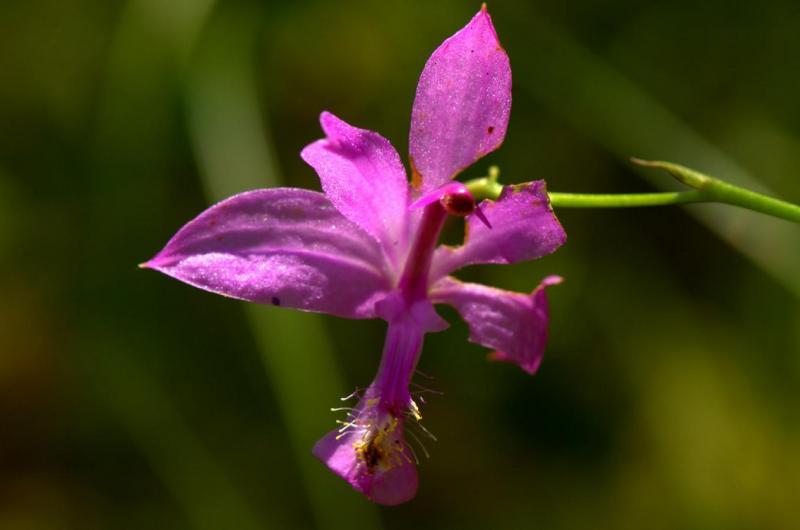Calopogon tuberosus
Also known as: Grass Pink or Limodorum tuberosum var. nanum Calopogon pulchellus var. simpsonii Calopogon pulchellus var. latifolius Limodorum simpsonii Limodorum pulchellum Bletia tuberosa Calopogon tuberosus var. tuberosus Calopogon tuberosus h.v. tuberosus h.f. albiflorus Calopogon tuberosus var. simpsonii Calopogon pulchellus f. albiflorus Calopogon pulchellus f. latifolius Cathea pulchella Cathea pulchella f. albiflora Cathea pulchella f. linearifolia Calopogon tuberosus f. niveus Calopogon tuberosus var. latifolius Cathea tuberosa Calopogon tuberosus f. albiflorus Cathea pulchella f. latifolia Calopogon tuberosus h.v. albus Calopogon pulchellus Helleborine tuberosa Limodorum tuberosum f. albiflorum Limodorum tuberosum f. latifolium Limodorum tuberosum f. linariifolium in the subfamily: Epidendroideae
Native to: Canada Florida - United States Kentucky - United States New Jersey - United States New York - United States Pennsylvania - United States Texas - United States
General Information
Grass Pink is a cold to warm growing terrestrial orchid belonging to the sub family Epidendroideae native to Canada and United States.
Plant Description
Grows to 120cm. Each new growth has numerous lance shaped leaves that grow to 4-50cm long. Pseudobulbs grow to 2cm
Flowers
Numerous blossoms appear during Summer and Spring
Blooming Season
- Spring
- Summer
Substrate(s)
- Charcoal
- Spaghnum Moss
- Perlite
- Sand
Care Notes
These orchids grow on the forest floor so are used to rich soil containing plenty of organic matter that is always moist (but not always wet), and prefer constant conditions in terms of humidity, temperature and water supply. They may not be as forgiving as epiphytes in regards to sudden changes in growing conditions so it is wise to ease them into new conditions over a the space of a few days, and repot as infrequently as possible.
Keep an eye on the plants condition regularly as they can decline suddenly if the conditions are not just right. It is more important to keep water supply constant rather than frequent - overwatering often causes rot which can quickly set in, especially in warmer conditions.
These can be grown in shady, moist areas in the garden, supplied they have protection from abrupt changes caused by the elements, e.g. dry winds, frost etc. Being grown around companion plants such as ferns and bromeliads will help build and retain the humidity they require throughout the year.
Climate
These orchids grow in cool climates, at low altitudes, in cool plains, forests or coastal scrub.
They are forgiving of humidity variances as long as temperatures are kept on the cool side. They can do well outdoors in the garden in cool and temperate areas, though it is important that they are protected from warm dry winds. They can enjoy morning sun especially in winter but will need protection from the hot sun in the afternoon and during summer. With some acclimatisation they may be able to receive more sun.
Grows at low elevations. Rainfall ranges from 25mm to 112mm per day, heaviest in June and lightest in January. Humidity ranges from 60% to 77%, highest in December and lowest in May. Temperature ranges from -14C to 28C, highest in July (17C to 28C) and lowest in January (-14C to -6C).
Fertiliser
These plants do well with slow release fertiliser at the rate of 2-3 pellets per cup (250ml) of media. Additional fertiliser during the growth period may be beneficial, but not necessary.
Be sure to flush out excess fertiliser by running water through the media regularly year round.Potting
These plants can be sensitive to repotting though should not require repotting regularly. Repotting should be done when the mix has broken down to the point that it doesn't absorb water or holds onto water for far too long, usually the plant shows a decline in growth as well.
The mix should be free draining, with a blend of 30% inorganic ingredients such as coarse sand, gravel or perlite, mixed in with about 70% organic ingredients such as peat, leaf litter or decomposed bark. Avoid commercial potting mixes as they can vary wildly and may contain "wetting agents" that can hold onto water for loo long, causing rotting and stunted growth.





















